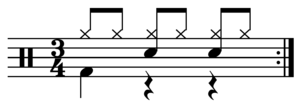Triple metre

Triple metre (or Am. triple meter, also known as triple time) is a musical metre characterized by a primary division of 3 beats to the bar, usually indicated by 3 (simple) or 9 (compound) in the upper figure of the time signature, with 3
4, 3
2, 3
8 and 9
8 being the most common examples. The upper figure being divisible by three does not of itself indicate triple metre; for example, a time signature of 6
8 usually indicates compound duple metre, and similarly 12
8 usually indicates compound quadruple metre.
It is reasonably common in ballads and classical music but much less so in traditions such as rock & roll and jazz. The most common time in rock, blues, country, funk, and pop is quadruple.[1] Jazz writing has become more adventurous since Dave Brubeck's album Time Out, [2][3][4] One noteworthy example of a jazz classic that employs triple metre is John Coltrane's version of "My Favorite Things". [5]
Triple time is common in formal dance styles, for example the waltz, the minuet and the mazurka, and thus also in classical dance music.
Movements in triple time characterized the more adventurous approach of 17th- and 18th-century music, for example the sarabande, which originated in Latin America and appeared in Spain early in the 16th Century, became a standard movement in the suite during the Baroque period. The Baroque sarabande is commonly a slow triple rather than the much faster Spanish original, consistent with the courtly European interpretations of many Latin dances.
Triple metre is rare in national anthems – the national anthems of Austria, the United Kingdom, Switzerland, and the United States being four notable exceptions.
Triple metre in song
There are many classical works in triple metre. Joseph Haydn's "Farewell" Symphony is an interesting case, as the first three movements are all in triple meter, as is the "farewell" section of the final movement.
In hymns and other religious works it is still common, with tunes such as Dave Bilborough's Abba, Father following from more traditional melodies such as Slane (adapted form a traditional Irish melody), Cloisters (written in the 16th Century), Amazing Grace and Rock of Ages.
Examples of triple metre in contemporary pop music
In contemporary pop traditions (Soul, Rap, R&B, Rock) triple metre is much less common but examples do exist:
- The verses of "Lucy in the Sky with Diamonds" from The Beatles' 1967 album, Sgt. Pepper's Lonely Hearts Club Band
- "Manic Depression" from the 1967 album, Are You Experienced?, by Jimi Hendrix
- "The Way Young Lovers Do" from the 1968 album, Astral Weeks, by Van Morrison
- "You Ain't The First" from the 1991 album, Use Your Illusion I, by Guns N' Roses
- "The Voice", winner of Eurovision Song Contest 1996, (Written & Composed by Brendan Graham) performed by Eimear Quinn
- "Miss Misery" from the soundtrack to the 1997 film Good Will Hunting, by Elliott Smith (nominated for the Academy Award for Best Original Song)
- The verses of "3 Libras" from the 2000 album, Mer de Noms, by A Perfect Circle
- "It's About Time" from Young the Giant's 2014 album, Mind over Matter
- "Amar Pelos Dois", winner of Eurovision Song Contest 2017, (Written & Composed by Luísa Sobral) performed by Salvador Sobral
Some album titles reference the time signature like Jimmy Buffett's third album Living and Dying in 3/4 Time, jazz drummer Max Roach's Jazz in 3/4 Time and Davey Graham and Alexis Korner's 1962 EP 3/4 AD .
SWV's 1992 R&B hit "Weak" includes the lyrics "cause my heart starts beating triple time" but the song is in 4
4 time.
In film music, the score to Peter Pan by James Newton Howard is remarkable in that it is almost entirely written in triple meter.
Sources
- 1 2 Schroedl, Scott (2001). Play Drums Today!, p.42. Hal Leonard. ISBN 0-634-02185-0.
- ↑ May, Chris. "Dave Brubeck Quartet: Time Out" All About Jazz December 15, 2011 Retrieved March 14, 2017
- ↑ Lamb, Evelyn "Uncommon Time: What Makes Dave Brubeck's Unorthodox Jazz Stylings So Appealing?" Scientific American December 11, 2012 Retrieved March 14, 2017
- ↑ Smith, Hedrick; Hackel, Cliff "Brubeck's Trademark Style: Odd Time Signatures, Polyrhythms and Polytonality" PBS:Rediscovering Dave Brubeck Released 16 December 2001 Retrieved March 14, 2017
- ↑ Gary Giddins (22 October 1998). Visions of Jazz: The First Century. Oxford University Press. p. 485. ISBN 978-0-19-987953-3.
